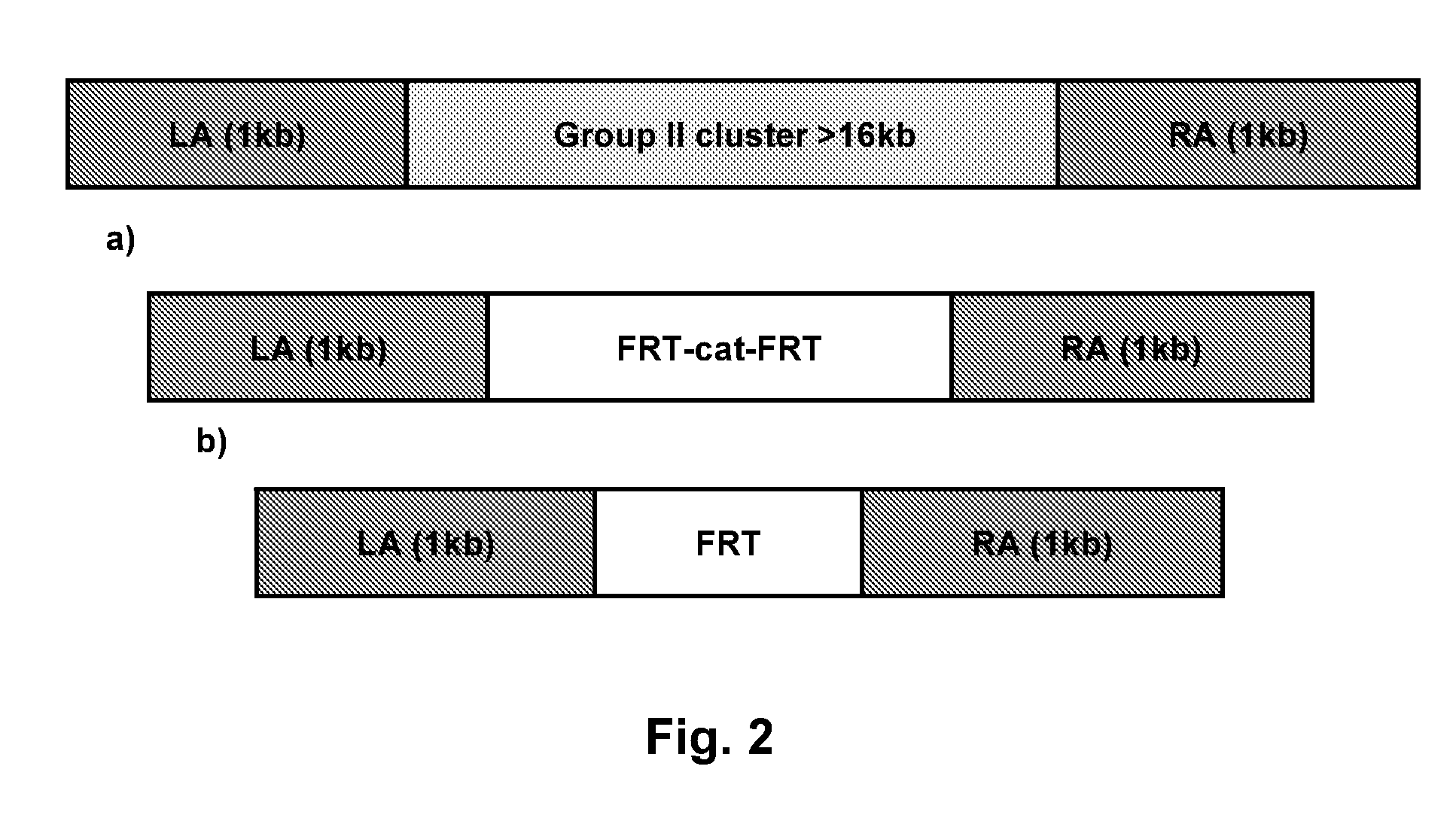E. coli BL21 strain lacking a functional group II capsular gene cluster
- Summary
- Abstract
- Description
- Claims
- Application Information
AI Technical Summary
Problems solved by technology
Method used
Image
Examples
example 1
Construction of Replacement Cassette
[0101]The E. coli B BL21(DE3) strain was used as a source of DNA for PCR amplification. Oligonucleotide primers (LA_BL_GII_F / LA_BL_GII_R) (Table 3) were synthesized, targeting a 1001bp region upstream of the 5′ end of KpsM containing SacII / EcoRI cloning site. This region was amplified from genomic DNA as left arm (LA). For the right arm (RA), oligonucleotide primers (RA1_BL_GII_F / RA1_BL_GII_R) (Table 3) were synthesized, targeting a 1108 bp region upstream of the 5′ end of KpsF containing BamHI / SacI cloning site. PCR products of the left arm and the right arm were generated. The DNA amplification reaction was performed in a thermal cycler, using a program that included the following parameters: denaturation at 94° C. for 50 s, annealing at 57° C. for 60 s and primer extension at 72° C. for 60 s, for a total of 30 cycles. The PCR amplification product with correct band size was observed by gel electrophoresis on a 1% agarose gel, from which 50 μl o...
example 2
Production of a Knock Out BL21(DE3) Strain
[0103]E. coli BL21(DE3) was grown in LB medium overnight at 37° C. and the heat shock competent cells of BL21(DE3) were prepared by standard methods. The plasmid pKD46 was transformed into BL21(DE3) competent cells and the transformed cells were grown to 0.4 OD600nm in LB broth supplemented with 100 μg / ml ampicillin at 30° C. The expression of Red recombinase was induced by L-arabinose (final concentration 1 mmol / l) for one hour.
[0104]For group II gene cluster knock out, 500 ng of replacement fragment amplified from pEZ-T-LA-FRT-cat-FRT-RA were transferred into BL21(DE3) competent cells by electroporation. The electrotraporation competent cells were prepared by standard methods. Recovery of the cells was carried out at 30° C. for 1.5 hours. The cells were plated on LB agar supplemented with 8 μg / ml chloramphenicol. Chloramphenicol-resistant colonies of BL21(DE3)ΔkpsM-kpsF)::cat were formed after overnight incubation at 30° C.
[0105]To ensure ...
example 3
Elimination of Drug-Resistant Marker and Characterization of group II Knock Out Strain
[0111]E. coli BL21(DE3)Δ(kpsM-kpsF)::cat and BL21(DE3)ΔdadXΔal(kpsM-kpsF)::cat cells from frozen stock were grown in LB medium overnight at 37° C. with 25 μg / ml chloramphenicol or 25 μg / ml chloramphenicol, plus 100 mM D-alanine for the second strain. The electroporation competent cells of the two knock out strains were prepared by standard methods. The plasmid pCP20 (CmR, AmpR) was transformed into the two knock out competent strains. The elimination of the drug-resistant marker was carried out by growing the transformed cells in SOC broth at 30° C. for 1 hour with gentle shaking. The single colonies of ampicillin resistant candidate clones on the plate were selected after overnight culture at 30° C. The candidate clones were grown in LB medium only or LB medium supplemented with D-alanine at 37° C. for three hours, to eliminate the plasmid pCP20. Five single colonies, which appeared on LB medium o...
PUM
| Property | Measurement | Unit |
|---|---|---|
| temperature | aaaaa | aaaaa |
| concentration | aaaaa | aaaaa |
| induction time | aaaaa | aaaaa |
Abstract
Description
Claims
Application Information
 Login to View More
Login to View More - R&D
- Intellectual Property
- Life Sciences
- Materials
- Tech Scout
- Unparalleled Data Quality
- Higher Quality Content
- 60% Fewer Hallucinations
Browse by: Latest US Patents, China's latest patents, Technical Efficacy Thesaurus, Application Domain, Technology Topic, Popular Technical Reports.
© 2025 PatSnap. All rights reserved.Legal|Privacy policy|Modern Slavery Act Transparency Statement|Sitemap|About US| Contact US: help@patsnap.com



